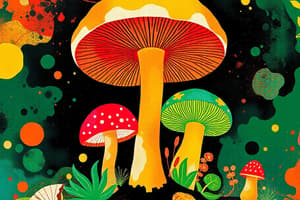Podcast
Questions and Answers
What is the primary structure that produces and contains spores in Rhizopus?
What is the primary structure that produces and contains spores in Rhizopus?
- Sporangium (correct)
- Zygospore
- Gametangium
- Mycelium
What type of reproduction involves the formation of gametangia in Rhizopus?
What type of reproduction involves the formation of gametangia in Rhizopus?
- Sexual reproduction (correct)
- Asexual reproduction
- Vegetative reproduction
- Binary fission
What is formed when two compatible hyphae fuse in the sexual reproduction of Rhizopus?
What is formed when two compatible hyphae fuse in the sexual reproduction of Rhizopus?
- Mycelium
- Hyphal coil
- Zygospore (correct)
- Sporangiospore
Under what conditions do spores of Rhizopus typically germinate to form mycelium?
Under what conditions do spores of Rhizopus typically germinate to form mycelium?
What role does Rhizopus play in ecosystems?
What role does Rhizopus play in ecosystems?
Flashcards are hidden until you start studying
Study Notes
Life Cycle of Rhizopus
-
General Overview:
- Rhizopus is a genus of fungi commonly known for causing bread mold.
- Its life cycle includes both sexual and asexual reproduction.
-
Asexual Reproduction:
- Sporangiospores:
- A sporangium develops at the end of specialized hyphae called sporangiophores.
- Inside the sporangium, spores (sporangiospores) are formed.
- When mature, sporangium ruptures, releasing spores into the environment.
- Germination:
- Spores land on a suitable substrate (e.g., decaying organic matter).
- Under favorable conditions, spores germinate to produce hyphae, forming a mycelium.
- Sporangiospores:
-
Sexual Reproduction:
- Formation of Gametangia:
- Two compatible hyphae (positive and negative strains) approach each other.
- They form gametangia (swellings) at their tips.
- Fertilization:
- The gametangia fuse to form a zygospore, a thick-walled resting spore.
- Zygospore Development:
- The zygospore undergoes meiosis when conditions are favorable, producing haploid spores.
- The zygospore develops a sporangium from which new sporangiospores are produced, completing the cycle.
- Formation of Gametangia:
-
Key Features:
- Hyphae: Filamentous structures that make up the mycelium; can be coenocytic (aseptate).
- Sporangium: Structure that produces and contains spores.
- Zygospore: Thick-walled, resistant structure that enables survival during adverse conditions.
-
Environmental Factors:
- Optimal growth occurs in warm, moist environments.
- Affects various substrates, especially those rich in carbohydrates.
-
Ecological Role:
- Decomposers that play a significant role in nutrient cycling in ecosystems.
General Overview
- Rhizopus is a genus of fungi known for causing bread mold.
- Life cycle includes both sexual and asexual reproduction methods.
Asexual Reproduction
-
Sporangiospores:
- Developed in a structure called a sporangium, located at the end of sporangiophores, which are specialized hyphae.
- Mature sporangium ruptures to release spores into the environment.
-
Germination:
- Spores, landing on suitable substrates like decaying organic matter, germinate under favorable conditions.
- Germination leads to the formation of hyphae, creating a mycelium.
Sexual Reproduction
-
Formation of Gametangia:
- Compatible hyphae, one positive and one negative strain, approach and form gametangia (swellings) at their tips.
-
Fertilization:
- Gametangia fuse to create a zygospore, characterized by its thick wall that aids survival.
-
Zygospore Development:
- The zygospore undergoes meiosis under favorable conditions, generating haploid spores.
- Eventually, a sporangium develops from the zygospore, leading to the production of new sporangiospores.
Key Features
- Hyphae: Filamentous structures constituting the mycelium; can be coenocytic (without septa).
- Sporangium: A structure that produces and houses spores.
- Zygospore: A resistant, thick-walled structure important for survival during unfavorable conditions.
Environmental Factors
- Optimal growth occurs in warm, moist environments.
- Rhizopus flourishes on substrates rich in carbohydrates.
Ecological Role
- Acts as a decomposer, significantly contributing to nutrient cycling within ecosystems.
Studying That Suits You
Use AI to generate personalized quizzes and flashcards to suit your learning preferences.



